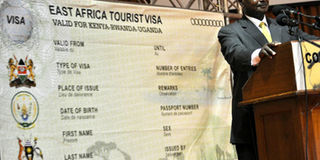How single tourist visa will work in East Africa

President Museveni addresses dignitaries in Kampala recently. The East African Tourist Visa allows member states to collect revenue from foreigners entering the region. PHOTO by RACHEL MABALA
What you need to know:
In another interview with the managing director of Kenya Tourism Board (KTB), Muriithi Ndegwa, it was evident that the move makes it easier, especially in terms of visa costs to visit the region
Member states stand a chance to collect more revenue from tourists, thanks to the East African Tourist Visa that was rolled out recently.
Industry players, however, say although the launch by the three Presidents of Uganda, Kenya and Rwanda is symbolically powerful, the tourism potential should have been realised much earlier and that this should be harvesting time.
Going by the remarks made by President Museveni (Uganda), President Kenyatta Uhuru (Kenya) and President Paul Kagame (Rwanda), there is a deliberate effort to speed up the integration process and spur the regional economy.
With the Single East Africa Visa, tourists can freely tour Uganda, Kenya and Rwanda at the cost of $100 (about Shs250, 000) only.
The proceeds will thereafter be shared among the countries the tourist visits with the highest amount—of $40 (about Shs98,000) going to the country that first registered the visitor.
Benefits
In an interview with Uganda Tourism Board chief executive officer Stephen Asiimwe, Uganda has everything to gain from the single visa initiative given that it is one of the countries in the region that attracts fewer tourists.
He said: “There is no doubt that our numbers [of tourist visits] will shoot up exponentially. This is because the single visa gives the tourists more for less.”
He continued: “Normally tourists who come here wants to experience the whole region. For example, a tourist will want to spend some days in Nairobi, then proceeds to Uganda and then Rwanda. We have now made that easy with the single visa that will allow a tourist to roam across the three countries with no restriction at all.”
The other two East African countries namely Tanzania and Burundi, although cognizant of the development, will not enjoy the benefits of the EA single visa just yet.
This means visitors heading to both EAC countries will have to abide by the visa requirement imposed by the two states.
According to Mr Asiimwe, travellers across the world regard the EAC region as a potential visiting destination. Therefore, packages such as single rather than multiple visas are aimed at boosting the chances of the region and the countries therein further.
In another interview with the managing director of Kenya Tourism Board (KTB), Muriithi Ndegwa, it was evident that the move makes it easier, especially in terms of visa costs to visit the region.
He said: “Previously, you were required to pay $50 (about Shs122, 000) to visit any of the East African countries. But now you can do that (visit Uganda, Kenya and Rwanda) at a visa cost of $100.
He continued: “We are looking at the numbers that the convenience will bring.”
According to regional tourism boards, at least one billion travellers across the world look at EAC as visiting destination. And it is understood that it is against this background that the three regional tourism boards have swiftly moved to tap into the opportunity that the numbers present to the tourism industry.
Ms Rica Rwigamba, the head of tourism and conservation department in Rwanda, told Prosper magazine in an interview that the initiative is meant to strengthen the respective countries’ tourism sectors.
“We are looking at marketing ourselves as well not just as individual countries but as a region and what we can offer to the world,” Ms Rwigamba said.
Industry players and analysts like Mr Amos Wekesa, say the industry deserves much more than that.
Mr Wekesa, who is also the managing director of Great Lakes Safaris— one of the country’s biggest tour operators, said in an interview that since marketing has been the major problem. For a country like Uganda, all the proceeds that will be accrued from the visa collection fees should be re-invested in marketing.
He said: “The problem of the region compared to other tourism destinations in the world are around marketing. And not until that is sorted out the initiative—single visa will not mean anything much.”
He continued: “The only way to make this work is by investing in marketing. For Uganda which is struggling to raise the numbers, it should have specific adverts that will entice tourists to visit it and then proceed to other countries.”
Issuance of E.Africa tourist visa
The heads of state directed Kenya to develop sample application form and share it with the partner states for inputs within two weeks after the summit.
The partner states will have a joint promoting committee. So far, a web portal has been formed as www.visiteastafrica.org. It will be hosted by Rwanda which will also pay for the domain name for the first year. Subsequently, payment shall be revolved among the partner states.
Ministers of finance, foreign affairs and internal affairs of the partner states are also yet to meet and agree on modalities for a special visa fees account.




